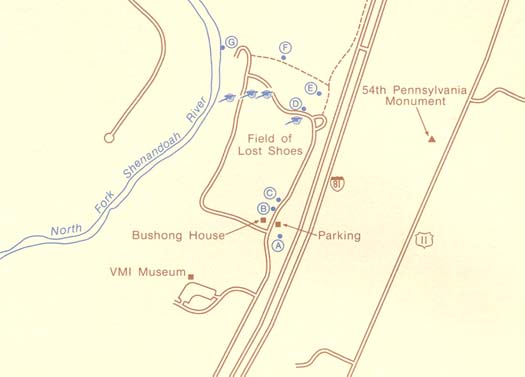STOP A
Jackson's Battery, 62d Va.
From the Bushong House parking lot, walk about 60 yards southeast
to a point between the blacksmith shop and Interstate 81. About 30
yards south of you, note the single gun. It denotes the approximate final
location of Jackson's Battery, which followed in direct support of the
advancing Confederate infantry. General Breckinridge observed events around
the Bushong House from a point several hundred yards to the southwest,
closer to US 11.

Looking directly north you will see a shallow gully beginning near the
Bushong House parking lot. It is intercepted by the interstate but continues
eastward about 250 yards toward US 11. Colonel George S. Smith's 62d Virginia,
with Captain Charles H. Woodson's Co. A, 1st Missouri Cavalry attached,
moved through the gully to the ridge about 200 yards to the north. There,
the regiment hit a wall of Federal artillery and infantry fire and fell
back to the relative shelter offered by the gully. Colonel George H. Smith,
62d Virginia Mounted Infantry, recalled,
When we reached the line of the fence beyond Bushong's house, the
right of the 51st Regiment became exposed to a heavy fire from the enemy's
line, and the regiment halted and commenced firing. The 62d continued to
advance, and on passing the slight elevation in front of it and reaching
the depression beyond came under the close concentrated artillery and infantry
fire of the Federal line, losing in a very few minutes over two hundred
of the men. The whole loss of the regiment in the fight was two hundred
and forty-one out of an aggregate of about five hundred, including seven
of the captains. These, it should be mentioned, were eleven in all, including
Captain [Woodson], commanding a company of Missourians, which had been
temporarily assigned to us, which did good service and suffered severely.
Seeing it impossible to effect anything with the remaining two hundred
and fifty or two hundred and sixty men, I ordered the regiment to fall
back, which it did, halting after passing the elevation referred to and
immediately re-forming and upon the 22d Regiment coming on its left, and
advancing with it.
Cpt. Conrad Currence, G. Co., 62d Va., was killed trying to grab his
colors. Of the 11 companies making up the regiment, seven lost their commanders.
100 out of 442 men were lost in this ravine. The fire was the hottest I
was ever under.
Farther west, the 30th and 51st Virginia were having an equally bad time.
The men had forged their way forward against the Federal fire through the
Bushong property to a fence on its north side. The intense fire proved
too much for many of them and they began to drift back to the greater shelter
offered on the south side of the Bushong buildings. General Breckinridge
noticed this and ordered his aide, Maj. Charles Semple, to go over and
restore order. Semple pointed to the cadets standing in reserve in what
is now the open field between the museum building and the Bushong House
and asked, "General, why don't you put the cadets in line? They will fight
as well as our men?" Breckinridge replied, "No, Charley, this will not
do, they are only children and I cannot expose them to such a fire as our
center will receive." Semple ran over and found the situation irretrievable.
He came back to Breckinridge and said, "General, it is too late. The Federals
are right on us. If the cadets are ordered up we can close the gap in our
center." Breckinridge then ordered: "Major, order them up and God forgive
me for the order." Cadet John H. Upshur described the VMI Corps' movement
forward.
On the northern border of this field and to our front, stood Bushong's
house, beyond which was an apple orchard. The enemy had slowly fallen back
and taken up a third position several hundred yards beyond this house.
On reaching the house, the ranks divided, A and B Companies passing to
the right of the house, and C and D Companies to the left; A and B marking
time until the other half came up and the line was reformed.
Cadet Willis O. Harris recalled in a 1909 letter to Cadet Capt. Henry A.
Wise,
In passing over the ground occupied by the farm-house . . . and its
outhouses and orchard, we were thrown into disorder, especially in getting
over a picket fence.
Return to Table of Contents
page created 20 December 1999
Return to
CMH Online

